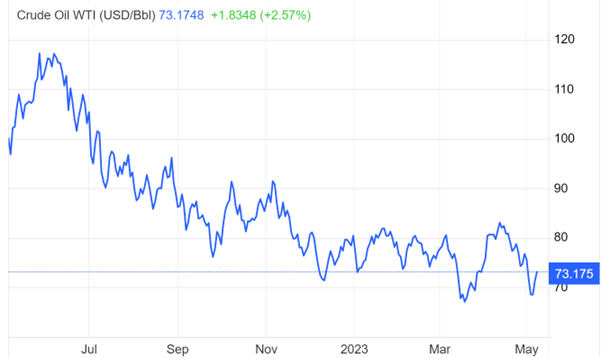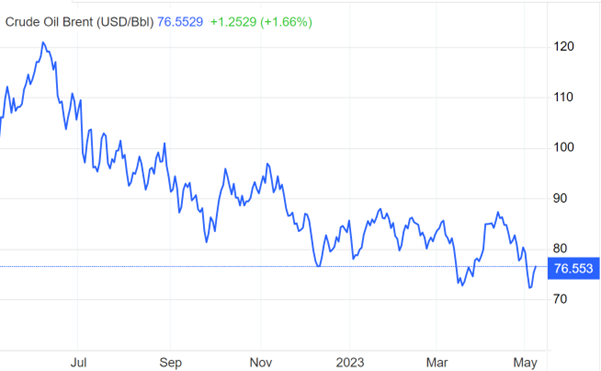
Oil prices have experienced a dramatic decline in prices in recent months. The price of Crude oil, which is considered a benchmark for US prices, was $117 in June 2022. It has declined to $73 by May 2023 – a decrease of 37 percent in just 11 months.

Source: Trading Economics
The price of Brent crude oil which is considered an international benchmark also significantly went down from $120 per barrel in June 2022 to about $76.5 in May 2023, which is a decrease of 36.25 in just one year.

Source: Trading Economics
The decline in oil prices raises a lot of questions: what are the causes of the current slump in crude oil prices? What will be the impact of the oil price slump on the global economy? And, how will crude oil prices behave in the months ahead? These are some of the questions that we will address in this blog post.
Oil prices have been on a downward spiral for the past year. There can be several reasons for low oil prices, including:
Low oil prices can have a significant impact on the global economy and can be influenced by a range of factors, both internal and external to the oil industry.
An important factor with regards to the slump in oil prices is the impact of low oil prices on the global economy.
As with most economic questions, the answer is not straightforward. It depends on whether a country is an oil-exporting nation or not.
If a country relies on oil exports, the decline in oil prices will reduce their export revenues and GDP, as seen in 2015 across many oil-exporting nations, prompting some countries like Russia, Kazakhstan, and Azerbaijan to move to more flexible exchange-rate regimes.
Moreover, the low oil price could also serve as a stimulus for more prudent economic policies, with some oil-exporting countries reducing wasteful spending and energy subsidies, such as gulf countries.
For oil-importing nations, the economic impact of lower oil prices depends on the reason for the price drop. If the price falls due to increased oil supply, consumers have more money to spend on domestic products, boosting the domestic economy.
Similarly, if consumers require less oil due to better alternatives, the impact could be positive.
However, if the low oil price results from troubles in the global economy, it is a symptom of underlying issues rather than a reason for optimism. Thus, while low oil prices could provide some modest stimulus to oil-importing countries, they also indicate slowing global growth, raising concerns.
From an investment perspective, low oil prices can have a significant impact on energy stocks. When oil prices are low, it means that energy companies are making less money. This can lead to lower earnings, which can cause energy stocks to decline in price.
Additionally, low oil prices can also lead to consolidation in the energy industry. As energy companies struggle to make a profit, they may be forced to merge or sell off assets. This can also lead to lower stock prices.
However, it is important to note that not all energy stocks are created equal.
Some energy companies are more diversified than others, and they may be less affected by low oil prices. Additionally, some energy companies are focused on renewable energy sources, which are not as sensitive to changes in oil prices. So, low oil prices can have a variable impact on energy stocks. It is important to do your research and invest in energy companies that are well-positioned to weather the storm.
Oil prices are influenced by economic and geopolitical factors. The main factor that determines the trajectory of oil prices is the supply and demand.
Sanctions of Russia seem to have made little impact on the oil prices. Many countries including China, Germany, Turkey, India, and other countries continue to buy oil from Russia despite the restriction on trade with Russia due to its invasion of Ukraine.

Source: Visual Capitalist
Shale oil production in the US is also booming with innovative technologies due to which the country has less reliance on imported oil. The oil supply in Canada is also strong at about 4 million barrels per day (bpl/d) in 2022.
Iran also increased oil output pumping 2.65 million bpl/d to the market in February and March 2023. Libya has also bounced back from a slump injecting 1.16 million blp/d of crude oil to the market.
The global supply of oil is likely to remain high which will likely depress crude oil prices in the months ahead.
Oil prices are on a downward spiral in 2023. While low prices are good for consumers, the trend does not bode well for energy investors who have become accustomed to a boom and bust in oil prices. It is important to do your research and invest in energy companies that are well-positioned to weather the storm of low oil prices.